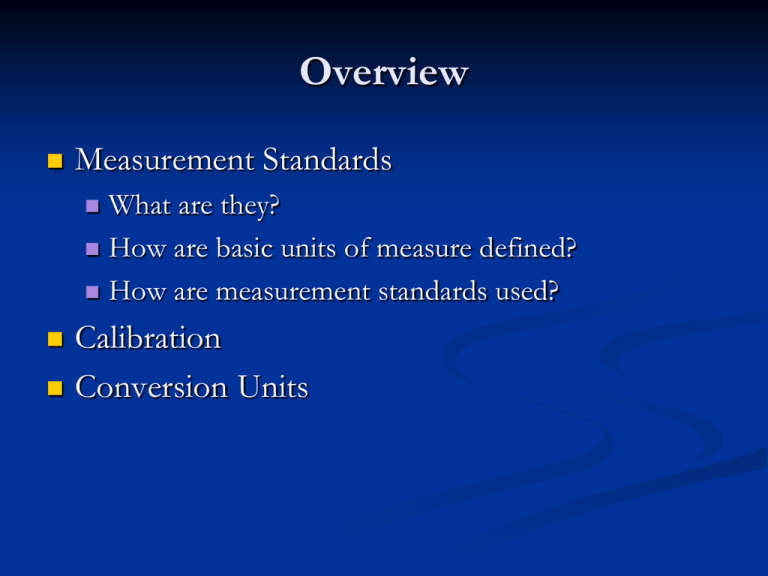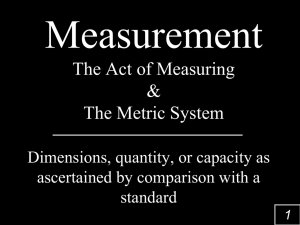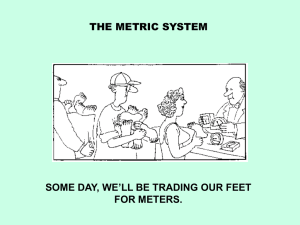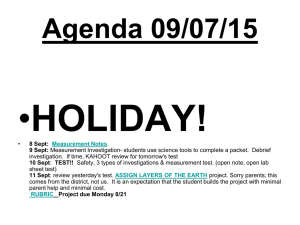What is a “Standard”?
advertisement

Overview Measurement Standards What are they? How are basic units of measure defined? How are measurement standards used? Calibration Conversion Units What is a “Standard”? A standard is something established as a rule or basis of comparison in measuring or judging capacity. Webster’s New World Dictionary Measurement Standards Before we can measure we need to define the unit of measure. How long is 1 meter? How much is 1 kg? How long is 1 second? How hot is 50 degrees C? Who defines standards? International Standards Organization, ISO National Institute of Standards and Technology, NIST Maintains SI (metric) standards. Mandated by the US Constitution International Bureau of Weights and Measures, BIPM (Bureau international des poids et mesures) in Sevres, France. Characteristics What are characteristics of a measurements standard? They must have global availability They must be accessible and “usable” They must be stable They must not change over time or location What is the basic unit of time? What is a year? The time required for the earth to make one complete orbit about the sun. What is a day? The time required for the sun to go from noon to noon. What is a second? Could be defined as: 1/(24X60X60) of a day Just a second! Measurement standards must be stable. But the length of a day is constantly changing Earth’s rotation is slowing Slowing is inconsistent Defining a second as 1/(24X60X60) of a day is no longer adequate! Next option? One Mississippi Two Mississippi Three Mississippi Four …. A “new” second? Since 1967 the second has been defined as: “The duration of 9,192,631,770 periods of the radiation corresponding to the transition between the two hyperfine levels of the fundamental state of the atom of cesium-133”. Beckwith, et al. “Atomic Clocks” Microwaves strike the cesium The frequency that maximizes the fluorescence is the natural resonance frequency The natural resonance frequency is 9,192,631,770Hz This defines the second. Is there a problem? What happens when a day does not contain 24X60X60 seconds? Sundials don’t match the atomic clock. Noon will shift, eventually occurring at night. Leap seconds are added as required Keeps noon in the middle of the day Just like leap days keep June at the beginning of summer How long is a meter? In 1889 the meter was redefined as the length of the International Prototype Meter (a physical artifact that defined a meter). Since 1983 the meter has been defined as the length light travels in a vacuum in 1/299,792,458 seconds. Inversely, the speed of light is now, by definition, 299,792,458m/s. What about US? Since 1959, the “international inch” is defined as 2.54 cm exactly! However, the US Coast and Geodetic Survey, (established in 1893) was based on the metric system and defined an inch as 1/39.37 meter (39.37inch = 1 meter, exactly). Beckwith, et al. The “survey inch” is 2.54000508 cm (1/39.37) Mass The kilogram was originally defined as the mass of 1 liter of water at 4ºC and 76 cm mercury atmospheric pressure (1 liter contains 1000 cubic centimeter). The kilogram was quickly replaced by a physical artifact. The mass of this specific platinum iridium bar is by definition, 1kg. This is still the definition, and it is the only primary standard based on a physical artifact. It is maintained by the International Bureau of Weights and Measures in Sèvres, France. What about US? Since 1959 the pound-mass has been defined as 0.4535937kg NIST maintains the US’s physical artifact, which is secondary to the International artifact in France. Getting warm? How warm? Temperature is much more complex to define. It requires definition at multiple points Fixed point Triple point of hydrogen Triple point of neon Triple point of oxygen Triple point of argon Triple point of mercury Triple point of water Melting point of gallium Freezing point of lanthanum Freezing point of tin Freezing point of zinc Freezing point of aluminum Freezing point of silver Freezing point of gold Freezing point of copper Temperature (K) 13.8033 24.5561 54.3584 83.8058 234.3156 273.16 302.9146 429.7485 505.078 692.677 933.473 1234.93 1337.33 1357.77 Triple point: the temperature at which solid, liquid and gas phases coexist. Interpolation between temperatures is defined by means of a platinum resistant thermometer, calibrated at the above temperatures. Wheeler and Ganji Triple Point video part I (in the video, watch at least from the 30 sec mark to the 4:30 mark) http://www.youtube.com/watch?v=qKDW1e3iNfs Triple Point video part II (watch through the 1:30 mark) http://www.youtube.com/watch?v=GafCi-3Xqko What about US? Conversion: F = 1.8C + 32 What about other things? The above units of measure are known primary or fundamental standards. Time (second) Length (meter) Mass (kg) Temperature Others (electrical, luminosity, angles, mole) All other measures are based off of the above basic units. These are known as secondary or derived standards. Velocity is distance per time Volume is length cubed, etc. NIST (National Institute of Standards and Technology) Government agency mandated by the US Constitution (Article I, Section 8). Responsible for defining and regulating weights and measures associated with US commerce. All measurements for engineering should be conducted using calibrated and certified instruments and tools (traceable to NIST). How does it work? NIST and other closely associated labs create physical artifacts and determine their characteristics (how long are they, etc.) Physical artifacts = calibration standards Calibration standards are used by labs to calibrate measurement instruments and tools. Calibration and Certification Calibration determines the uncertainty (error) of a measurement device by comparing its measurement with the appropriate measurement standard. “Uncertainty” is a statistical description of the difference between a measured value and the true value (the true value is never known, it is only estimated). Uncertainty is sometimes referred to as error. Certification is the documentation of the calibration “Unusual” Conversion Units… Ratio of an igloo’s circumference to its diameter: Eskimo Pi 2000 pounds of Chinese soup – Won ton 1 millionth of a mouthwash – 1 microscope Time between slipping on a peel and smacking the pavement – 1 bananosecond Weight an evangelist carries with God: 1 billigram Time it takes to sail 220 yards at 1 nautical mile per hour: Knotfurlong 365.25 days of drinking low-calorie beer because it’s less filling – 1 lite year 16.5 feet in the Twilight Zone: 1 Rod Serling Half of a large intestine: 1 semicolon 1000 aches: 1 megahurtz Basic unit of laryngitis: 1 hoarsepower Shortest distance between two jokes: a straight line 454 graham crackers: 1 pound cake 1 million-million microphones: 1 megaphone 1 million bicycles – 2 megacycles 2000 mockingbirds: two kilomockingbirds 120 cards: 1 decacards 1 kilogram of falling figs: 1 Fig Newton 1000 grams of wet socks: 1 literhosen 1 millionth of a fish – 1 microfiche 1 trillion pins: 1 terrapin 10 rations: 1 decoration 100 rations: 1 C-ration 2 monograms: 1 diagram 8 nickels: 4 paradigms 2.4 statue miles of intravenous surgical tubing at Yale University Hospital: 1 I.V. League 100 Senators: Not 1 decision REFERENCES Beckwith, Marangoni, and Lienhard, Mechanical Measurements, 5th ed., Addison-Wesley Publishing, 1993. Wheeler and Ganji, Introduction to Engineering Experimentation, Prentice Hall, 1996) DISCOVER, Vol. 25 No. 03, March 2004 Questions?






